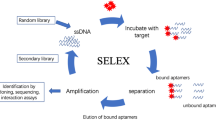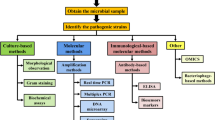Abstract
Based on a β-cyclodextrin (β-CD) subject-object competition model, a simple and sensitive electrochemical aptamer sensor for the determination of tetracycline (TET) was fabricated. First, the TET aptamer modified with ferrocene (Fc) as a signal molecule was captured by β-CD loaded onto the gold electrode. Subsequently, TET was added to the detection system, causing a binding event between the target and aptamer with strong affinity during which process the aptamer configuration was changed from the original upright linear state to an agglomeration structure, resulting in its departure from the electrode surface. Consequently, an “off-signal” was turned along with the presence of the target. The results indicated that the TET concentration had a linear response to the signal ranging from 0.01 to 100 nM and the accurate detection limit could reach as low as 0.008 nM (3δ). The fabricated TET biosensor also showed outstanding detection specificity. Moreover, the suitability of the developed method was demonstrated in the determination of TET concentrations in different samples comprising water, milk, and bacteria culture medium, achieving acceptable recoveries for spiked samples ranging from 96.0 to 104.4%. This detection system was simple, economical, time-saving but remarkably sensitive, selective, and efficient, potentially rendering services in food safety screening and medical testing.






Similar content being viewed by others
References
Baquero F, Martínez JL, Cantón R (2008) Antibiotics and antibiotic resistance in water environments. Curr Opin Biotechnol 19(3):260–265
Jensen VF, Neimann J, Hammerum AM, Mølbak K, Wegener HC (2004) Does the use of antibiotics in food animals pose a risk to human health an unbiased review. J Antimicrobe Chemother 54(1):274–275
Tan H, Ma C, Song Y, Xu F, Chen S, Wang L (2013) Determination of tetracycline in milk by using nucleotide/lanthanide coordination polymer-based ternary complex. Biosens Bioelectron 50(4):447–452
Aga DS, Randall G, Pankaj K (2003) Application of ELISA in determining the fate of tetracyclines in land-applied livestock wastes. Analyst 128(6):658–662
Gan T, Shi Z, Sun J, Liu Y (2014) Simple and novel electrochemical sensor for the determination of tetracycline based on iron/zinc cations–exchanged montmorillonite catalyst. Talanta 121:187–193
Taggart H, Bergstrom L (2014) An overview of the microbiome and the effects of antibiotics. J Nurse Pract 10(7):445–450
Asadollahi-Baboli M, Mani-Varnosfaderani A (2014) Rapid and simultaneous determination of tetracycline and cefixime antibiotics by mean of gold nanoparticles-screen printed gold electrode and chemometrics tools. Measurement 47(1):145–149
Kowalski P (2008) Capillary electrophoretic method for the simultaneous determination of tetracycline residues in fish samples. J Pharmaceut Biomed 47(3):487–493
Jalalian SH, Karimabadi N, Ramezani M, Abnous K, Taghdisi SM (2018) Electrochemical and optical aptamer-based sensors for detection of tetracyclines. Trends Food Sci Technol 73(1):45–57
Beltagi AM (2003) Determination of the antibiotic drug pefloxacin in bulk form, tablets and human serum using square wave cathodic adsorptive stripping voltammetry. J Pharmaceut Biomed 31(6):1079–1088
Ramezani M, Mohammad Danesh N, Lavaee P, Abnous K, Mohammad Taghdisi S (2015) A novel colorimetric triple-helix molecular switch aptasensor for ultrasensitive detection of tetracycline. Biosens Bioelectron 70(15):181–187
Monser L (2000) Rapid liquid chromatographic method for simultaneous determination of tetracyclines antibiotics and 6-epi-doxycycline in pharmaceutical products using porous graphitic carbon column. J Pharmaceut Biomed 23(2):353–362
Giraldo J, Althaus RL, Beltrán MC, Molina MP (2017) Antimicrobial activity in cheese whey as an indicator of antibiotic drug transfer from goat milk. Int Dairy J 69(4):40–44
Liu Y, Peng D, Huang L, Wang Y, Chang C, Ihsan A, Tao Y, Yang B, Yuan Z (2010) Application of a modified enzyme-linked immunosorbent assay for 3-amino-2-oxazolidinone residue in aquatic animals. Anal Chim Acta 664(2):151–157
Gupta BD, Kant R (2018) Recent advances in surface plasmon resonance-based fiber optic chemical and biosensors utilizing bulk and nanostructures. Opt Laser Technol 101:144–161
Wang S, Dong Y, Liang X (2018) Development of a SPR aptasensor containing oriented aptamer for direct capture and detection of tetracycline in multiple honey samples. Biosens Bioelectron 109:1–7
Jo M, Ahn JY, Lee J, Lee S, Hong SW, Yoo JW, Kang J, Dua P, Lee DK, Hong S (2011) Development of single-stranded DNA aptamers for specific bisphenol a detection. Oligonucleotides 21(2):85–91
Zhan X, Hu G, Wagberg T, Zhan S, Xu H, Zhou P (2016) Electrochemical aptasensor for tetracycline using a screen-printed carbon electrode modified with an alginate film containing reduced graphene oxide and magnetite (Fe3O4) nanoparticles. Microchim Acta 183(2):723–729
Zhou Y, Mahapatra C, Chen H, Peng X, Ramakrishna S, Nanda HS (2020) Recent developments in fluorescent aptasensors for detection of antibiotics. Curr Opin Biomed Eng 13:16–24
Sun Y, Lin Y, Sun W, Han R, Luo C, Wang X, Wei Q (2019) A highly selective and sensitive detection of insulin with chemiluminescence biosensor based on aptamer and oligonucleotide-AuNPs functionalized nanosilica@graphene oxide aerogel. Anal Chim Acta 1089:152–164
Li M-K, Hu L-Y, Niu C-G, Huang D-W, Zeng G-M (2018) A magnetic separation fluorescent aptasensor for highly sensitive detection of bisphenol A. Sensor Actuat B- Chem 266:805–811
Ni L, Yang G, Wang Q, Duan S, Shen C, Xie J, Niu G, Li H, Chen M, Diao G (2019) Supramolecular complexation of polysulfides by β-cyclodextrin polymer functionalized graphene hybrid cathode for high-performance lithium-sulfur batteries. Energy Storage Mater 21:378–389
Hu T, Na W, Yan X, Su X (2017) Sensitive fluorescence detection of ATP based on host-guest recognition between near-infrared β-cyclodextrin-CuInS2QDs and aptamer. Talanta 165:194–200
Tuerk C, Gold L (1990) Systematic evolution of ligands by exponential enrichment: RNA ligands to bacteriophage T4 DNA polymerase. Science 249(4968):505–510
Nguyen VT, Kwon YS, Gu MB (2017) Aptamer-based environmental biosensors for small molecule contaminants. Curr Opin Biotechnol 45:15–23
Ryabov AD, Tyapochkin EM, Varfolomeev SD, Karyakin AA (1990) Ferrocenes inside cyclodextrin cavities do not mediate the electron transport between glucose oxidase and an electrode. J Electroanal Chem 299(2):257–262
Sui C, Zhou Y, Wang M, Yin H, Wang P, Ai S (2018) Aptamer-based photoelectrochemical biosensor for antibiotic detection using ferrocene modified DNA as both aptamer and electron donor. Sensor Actuat B-Chem 266:514–521
Mehta J, Dorst BV, Rouah-Martin E, Herrebout W, Scippo ML, Blust R, Robbens J (2011) In vitro selection and characterization of DNA aptamers recognizing chloramphenicol. J Biotechnol 155(4):361–369
Fan H, Li H, Wang Q, He P, Fang Y (2012) A host-guest-recognition-based electrochemical aptasensor for thrombin detection. Biosens Bioelectron 35(1):33–36
Cui X, Li R, Liu X, Wang J, Leng X, Song X, Pei Q, Wang Y, Liu S, Huang J (2018) Low-background and visual detection of antibiotic based on target-activated colorimetric split peroxidase DNAzyme coupled with dual nicking enzyme signal amplification. Anal Chim Acta 997:1–8
Wang YH, Yao L, Ning G, Wu YH, Wu S, Mao SM, Liu G-Q (2019) An electrochemical strategy for tetracycline detection coupled triple helix aptamer probe with catalyzed hairpin assembly signal amplification. Biosens Bioelectron 143:111613
Wang YH, Ning G, Wu YH, Wu S, Zeng B, Liu G-Q, He XX, Wang KM (2019) Facile combination of beta-cyclodextrin host-guest recognition with exonuclease- assistant signal amplification for sensitive electrochemical assay of ochratoxin A. Biosens Bioelectron 124:82–88
Mehdizadeh Aghdam E, Hejazi MS, Barzegar A (2016) Riboswitches: from living biosensors to novel targets of antibiotics. Gene 592(2):244–259
Kitano H, Yoshiko Taira A, Yamamoto H (2000) Inclusion of phthalate esters by a self-assembled monolayer of thiolated cyclodextrin on a gold electrode. Anal Chem 72(13):2976–2980
Pilehvar S, Dierckx T, Blust R, Breugelmans T, Wael KD (2014) An electrochemical impedimetric aptasensing platform for sensitive and selective detection of small molecules such as chloramphenicol. Sensors 14(7):12059–12069
Saraf N, Woods ER, Peppler M, Seal S (2018) Highly selective aptamer based organic electrochemical biosensor with pico-level detection. Biosens Bioelectron 117:40–46
Wang Y, Sun Y, Dai H, Ni P, Shu J, Lu W, Zhen L, Zhuang L (2016) A colorimetric biosensor using Fe3O4 nanoparticles for highly sensitive and selective detection of tetracyclines. Sensor Actuat B-Chem 236:621–626
Qu F, Sun Z, Liu D, Zhao X, You J (2016) Direct and indirect fluorescent detection of tetracyclines using dually emitting carbon dots. Microchim Acta 183(9):2547–2553
Taghdisi SM, Danesh NM, Ramezani M, Abnous K (2016) A novel M-shape electrochemical aptasensor for ultrasensitive detection of tetracyclines. Biosens Bioelectron 85:509–514
Guo Z, Gai P (2011) Development of an ultrasensitive electrochemiluminescence inhibition method for the determination of tetracyclines. Anal Chim Acta 688(2):197–202
Funding
This work was supported by the Natural Science Foundation of Hunan Province, China (Grant No. 2018JJ2675 and 2018JJ3869), Science and Technology Program of Changsha (kq1907097), and the Training Program for Excellent Young Innovators of Changsha City (KQ1802021).
Author information
Authors and Affiliations
Corresponding author
Additional information
Publisher’s note
Springer Nature remains neutral with regard to jurisdictional claims in published maps and institutional affiliations.
Rights and permissions
About this article
Cite this article
Wu, Yh., Bi, H., Ning, G. et al. Cyclodextrin subject-object recognition-based aptamer sensor for sensitive and selective detection of tetracycline. J Solid State Electrochem 24, 2365–2372 (2020). https://doi.org/10.1007/s10008-020-04751-7
Received:
Revised:
Accepted:
Published:
Issue Date:
DOI: https://doi.org/10.1007/s10008-020-04751-7




